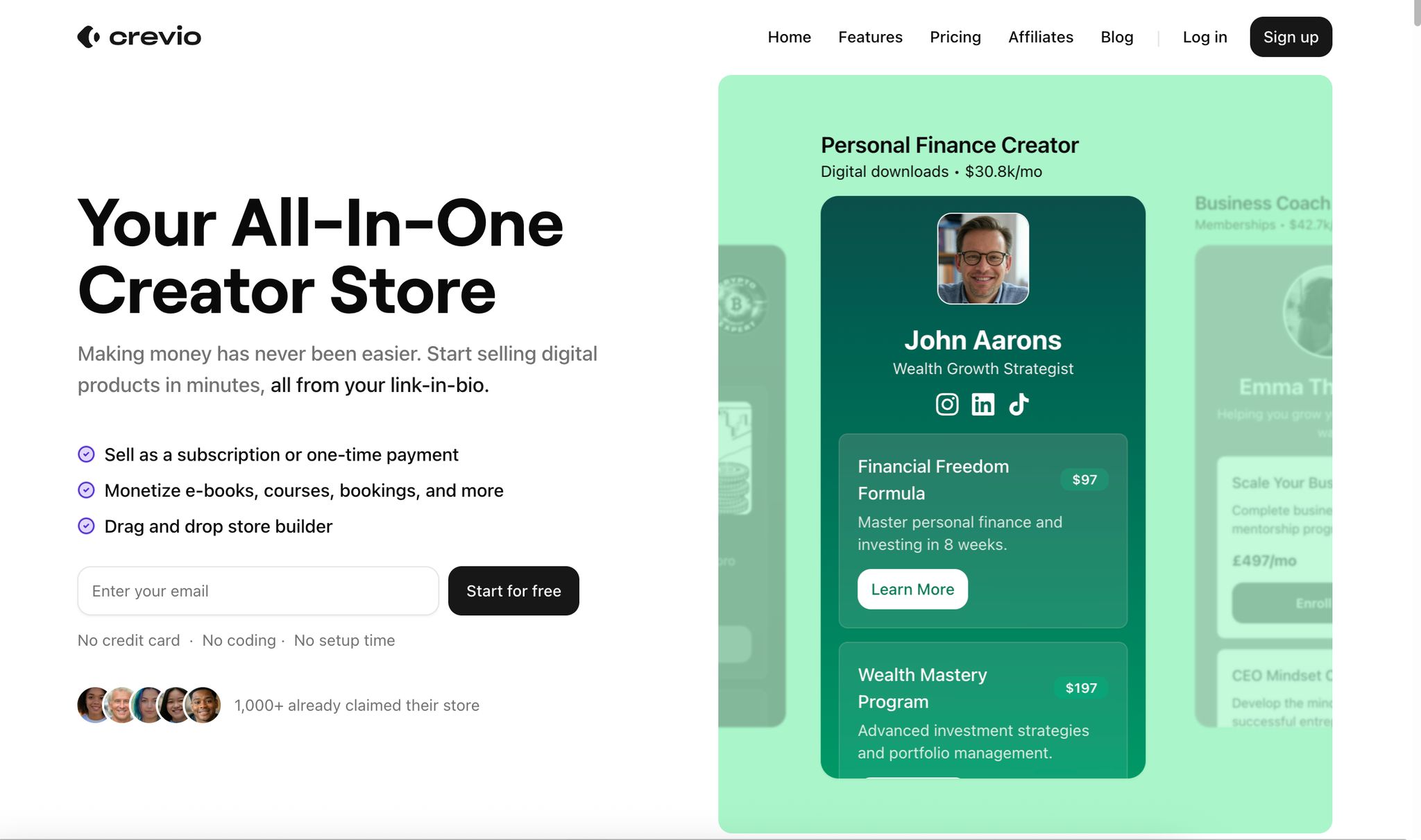What Is the Creator Economy – And Why Is It Booming?

The creator economy is reshaping how people earn money online. It’s a $250 billion industry with 50 million participants, including content creators, digital entrepreneurs, and independent artists. Here’s why it’s booming:
- Direct Monetization: Creators bypass traditional middlemen, earning through brand deals, digital products, memberships, and more.
- Platform Growth: Tools like Crevio allow creators to sell products and build their brands with minimal costs.
- Consumer Behavior: Audiences prefer personal, relatable content over traditional media.
- Lower Barriers: With easier access to technology and a growing global audience, anyone can start creating.
Success isn’t guaranteed – 97.5% of YouTubers don’t earn enough to surpass the U.S. poverty line. But with the right strategies, creators can thrive. The industry is expected to nearly double to $480 billion by 2027, offering massive opportunities for those ready to dive in.
Growth Drivers
Platform and Tool Evolution
Modern platforms now provide creators with advanced tools for planning, processing payments, and engaging with their audience – all with minimal upfront costs. These platforms have moved beyond simple content hosting, allowing creators to sell digital products, offer memberships, and connect external services using tools like Crevio’s mobile-friendly store builder. This gives creators the freedom to experiment with monetization methods while maintaining full control over their brand.
"As a result, we expect some element of a ‘flight to quality’ whereby creators will prioritize platforms with stability, scale and monetization potential" – Eric Sheridan, Senior Equity Research Analyst, Goldman Sachs Research
These advancements are reshaping how consumers engage with content, laying the groundwork for a major shift in the industry.
Shifts in Consumer Spending
The growth isn’t just about better tools – consumer behavior is evolving too. The traditional producer-consumer relationship has transformed into a direct, interactive connection. Consumers now play an active role in shaping brand reputations by sharing their experiences globally. With trust in big tech companies declining, the personal and relatable approach that creators bring is becoming increasingly appealing.
Lower Entry Barriers
Easier access to creation tools is another major factor behind this growth. As internet usage rises by 7.6% annually, with an estimated 5.3 billion users worldwide by 2023, the audience for creators keeps expanding. This accessibility has turned content creation into a realistic career option for many.
Take Logan Paul, for example. Starting as a vlogger on Vine, he earned $19 million in 2021 through YouTube advertising alone. Goldman Sachs Research estimates the creator economy will hit $480 billion by 2027, underscoring the explosive growth in this space.
With better platforms, a growing audience, and easier access to tools, the creator economy is thriving and shows no signs of slowing down.
Income Sources for Creators
Top Income Streams
The creator economy offers more ways to earn money than just advertising. For example, selling digital products has become a popular option. The e-learning market alone is expected to grow to $319 billion by 2029. This expanding market has opened doors for tools that help creators make money in new ways.
Brand partnerships are another key income source, with earnings varying based on audience size. From micro-influencers to big-name creators, this model has proven profitable. Take KSI, for instance – he earned $24 million in 2022 through various revenue channels.
"Think about sponsorships like a sales pipeline. Instead of waiting for brands to reach out, creators should conduct outbound prospecting, design systems to track and close deals more efficiently, and pitch brands on the next collaboration the moment the campaign ends." – Justin Moore, Sponsorship Coach and Founder of Creator Wizard
Selling digital products like online courses and educational content is also a major moneymaker. For example, Bonnie Christine earned $1.5 million in 2020 from her online courses, and Steph Smith made over $130,000 by selling her book Doing Content Right on Gumroad.
Using Crevio for Sales
 Crevio provides a platform for creators to sell digital products like ebooks, courses, and memberships while maintaining control over their brand. It supports both one-time payments and subscriptions, making it easier to generate recurring income. Plus, Crevio integrates with external tools like Discord and Telegram, giving creators more ways to deliver content and reach their audience efficiently.
Crevio provides a platform for creators to sell digital products like ebooks, courses, and memberships while maintaining control over their brand. It supports both one-time payments and subscriptions, making it easier to generate recurring income. Plus, Crevio integrates with external tools like Discord and Telegram, giving creators more ways to deliver content and reach their audience efficiently.
Success Stories
The success stories of creators highlight the opportunities within this thriving economy. For instance, Jay Acunzo shifted from public speaking to digital products during the pandemic. His online course, Growable Shows, brought in $15,000 in just two weeks after its launch.
"With the new business I have, where it’s educational products, a membership group, shows, content, and my newsletter, it all fits together nicely in one flow underneath that mission of helping people make what matters." – Jay Acunzo
Andrew Schulz’s FLAGRANT podcast earns over $100,000 per month through Patreon subscriptions. Similarly, Stefan Palios created the Freelance Growth Blueprint to help freelancers reach six-figure incomes, showing how niche expertise can turn into profitable digital products.
While nearly 30% of full-time creators make less than $10,000 annually, more than 15% earn over $150,000 per year. These examples show how combining different income streams can lead to sustainable and successful creator businesses.
Industry Changes
The creator economy is reshaping how media and marketing operate, driving shifts in traditional practices and fostering new opportunities.
Media Industry Shifts
With over 50 million independent creators in the mix, traditional media faces competition like never before. These creators are building direct, loyal connections with their audiences, pushing established media companies to rethink their strategies and adapt their business models.
"The creator economy is all about handing financial control to the content creators, where they reach out directly to their followers for funding." – kadeemclarke.eth, Head of Labs @ Momentum 6
New Marketing Approaches
Creator-driven content is proving to be more engaging than traditional organic methods. A whopping 92% of marketers report stronger engagement with sponsored creator content, and 86% of consumers have made purchases inspired by these collaborations.
"What AI does very effectively is lower the barrier to content creation so influencers can create better content with less effort. The tools are getting more accessible every year. More and more high-quality content is going to continue to shift the landscape because of that." – Taylor Lorenz, Journalist
The numbers speak for themselves:
| Metric | Percentage |
|---|---|
| Marketers seeing better engagement with creator content | 90% |
| Marketers linking creator content to higher conversions | 83% |
| Brand partnerships happening on Instagram | 57% |
| Consumers making purchases inspired by creators | 86% |
Niche Market Growth
The creator economy is also driving expansion in specialized markets. Many creators are focusing on specific audiences, building tight-knit communities and sustainable revenue streams.
In 2021, the influencer market was valued at $8 billion, with projections to hit $15 billion by the end of 2022. This growth is largely fueled by creators who cater to niche audiences, such as local creators and mid-tier influencers who maintain strong bonds with their followers. Brands are increasingly recognizing the power of these specialized creators and incorporating influencer marketing into their strategies, leveraging the ability of niche creators to deliver focused, impactful content.
Obstacles and Future Outlook
The creator economy is growing fast, but it comes with challenges that creators need to navigate to maintain success.
Standing Out Online
The digital space is more crowded than ever, making it harder for creators to get noticed. In the past, gaining visibility required less effort, but now the competition is tougher, and creators need smarter strategies to succeed.
| Challenge | Impact | Strategy |
|---|---|---|
| Declining organic reach | Less visibility | Build strong marketing skills |
| Rising paid social costs | Higher acquisition costs | Focus on retention strategies |
| Content saturation | Harder to grab attention | Target specific niche audiences |
| Platform algorithm changes | Unpredictable traffic | Create independent distribution channels |
Because of these challenges, many creators are looking to take more control over their platforms and audiences.
Platform Independence
More creators are working toward independence from major platforms. There are some great examples of how this can pay off. Megan Sumrell built a 7-figure business with fewer than 20,000 social media followers by launching her own mobile app. She shared, "I built my app very early. I call it my secret weapon."
Another example is hairstyling expert Nicki Bianco. She turned her skills into a steady income of over $300,000 per month through her app, Slice Squad, without relying on social media algorithms. This kind of independence helps creators avoid the pitfalls of declining organic reach and algorithm changes.
Future Developments
To tackle these hurdles, creators are leaning into new trends that are reshaping the industry:
"AI-created personas will quietly take over social platforms [as they] become indistinguishable from human creators", says Dave Snyder, partner and head of design at digital studio Siberia.
Some key shifts shaping the future include:
- Creators as Entrepreneurs
Creators are evolving into entrepreneurs. They’re building teams, launching brands, and branching out across multiple platforms. - New Content Formats
Content is moving beyond short-form dominance. James Brownstein, founder of influencer relations agency Poster Child, notes, "Short-form content is evolving into a TV season-like format, with brands sponsoring entire seasons, creating new engagement avenues." - AI in Content Creation
Artificial intelligence is becoming a major tool for creators. Roee Zelcer, CEO of Humanz U.S., highlights, "Creators will now need to explore more sophisticated ways to leverage AI to stand out."
Conclusion
Main Points
The creator economy has grown into a massive industry, currently valued at $250 billion and expected to reach $480 billion by 2027, according to Goldman Sachs Research. This growth is fueled by a steady increase in creators, expanding at a 10–20% annual rate.
Several factors are driving this growth:
| Growth Driver | Impact |
|---|---|
| Platform Evolution | Opens up new ways for creators to make money |
| Market Size | 5.3 billion internet users expected by 2023 |
| Revenue Diversity | Brand deals make up 70% of creator earnings |
With these trends in mind, now is a great time to start building your creator business.
Getting Started with Crevio
Use these insights to kickstart your creator journey with Crevio. For those ready to tap into this booming economy, Crevio provides tools to grow and monetize your content. Start by offering free content to attract an audience, then introduce premium subscriptions. Crevio’s mobile-friendly store builder and flexible content delivery options make it easy to establish your brand.
To succeed on Crevio:
- Pick your niche: Focus on areas where you can stand out and offer something special.
- Stay consistent: Post regularly to grow and engage your audience.
- Expand your income streams: Take advantage of Crevio’s monetization features to maximize earnings.
Crevio’s Basic plan costs $29/month and includes everything you need to get started. For those looking to scale, the Growth plan at $89/month offers unlimited product options and custom branding to grow your business.






